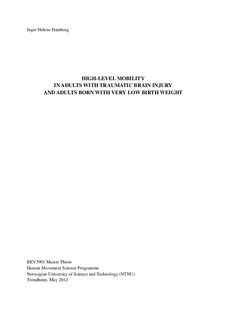| dc.description.abstract | Background and aim: Persons sustaining different types of brain injury may experience difficulties with advanced mobility. Both persons with traumatic brain injury (TBI) and persons born with very low birth weight (VLBW) have similar brain abnormalities, such as reduced white matter and connectivity, and may thus experience similar mobility problems. However, few studies have assessed advanced motor abilities, and none have compared mobility functions in adult TBI and VLBW populations. Our aim was to investigate high level mobility functions in adults with TBI and VLBW adults compared to matched controls, and to compare high-level mobility in TBI and VLBW adults.
Methods: Participants consisted of 22 subjects (mean age 22.9 ± 2.0 yrs) with chronic traumatic brain injury, and 35 subjects (mean age 22.5 ± 0.7 yrs) born preterm with birth weight (below 1500 grams). Two TBI participants were not able to complete all test items due to pain. The VLBW group included three subjects with cerebral palsy (CP). Each group was matched with its own control group, consisting of 24 subjects each from the same geographical area matched by age and sex. Mean age in the control group was 23.3 ± 1.8 yrs for TBI and 22.8 ± 0.5 yrs for VLBW. Advanced mobility functions were assessed by the High-level Mobility Assessment Tool (HiMAT), which consists of 13 timed mobility tasks, with a maximum total HiMAT score of 54.
Results: Mean total HiMAT score in the TBI group was 47.0 ± 7.7 compared to 50.3 ± 3.9 for the controls (U=193, p=0.116). Three of 13 mobility tasks differed significantly from the control group: ‘walking’, ‘walk over obstacle’ and ‘bound non-affected leg’. When the two subjects who reported pain were excluded from the analysis, mean total HiMAT score was 48.9 ± 4.9 (U=193, p=0.264), with ‘walking’ and ‘walk over obstacle’ remaining significantly different from the control group. In the TBI group, nine (40.9%) participants performed at or below the 5th percentile compared to 6 (25%) of the TBI controls. Mean total HiMAT score in the VLBW group was 45.1 ± 7.8 compared to 49.9 ± 3.5 in its control group (U = 256, p=0.011). Five of the 13 mobility task scores were significantly different from the control group: ‘walking backwards’, ‘running’, ‘hop affected leg’, ‘bound affected leg’, and ‘bound non-affected leg’. When the three subjects with CP were excluded, mean total HiMAT score was 46.8 ± 5.5 in the VLBW group (U=256, p=0.033) and three mobility task scores remained significantly different from the controls: ‘walking backwards’, ‘hop affected leg’ and ‘bound non-affected leg’. In the VLBW group, 17 (48.6%) participants performed at or below the 5th percentile compared to 4 (16.7%) of the VLBW controls. When directly compared to the VLBW group, the TBI group had (OR 0.733, CI 0.249 – 2.154) lower risk for performing at or below the 5th percentile, although not significant.
Conclusions: Compared to controls, adults with TBI had reduced high-level mobility in specific tasks. Adults born with VLBW had reduced overall high level mobility. Furthermore, the HiMAT seems to be a valuable tool for assessing high-level mobility in VLBW populations, and should be formally tested for further use.
Keywords: High-level mobility, high-level mobility assessment tool, traumatic brain injury, very low birth weight | nb_NO |
